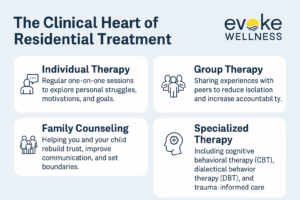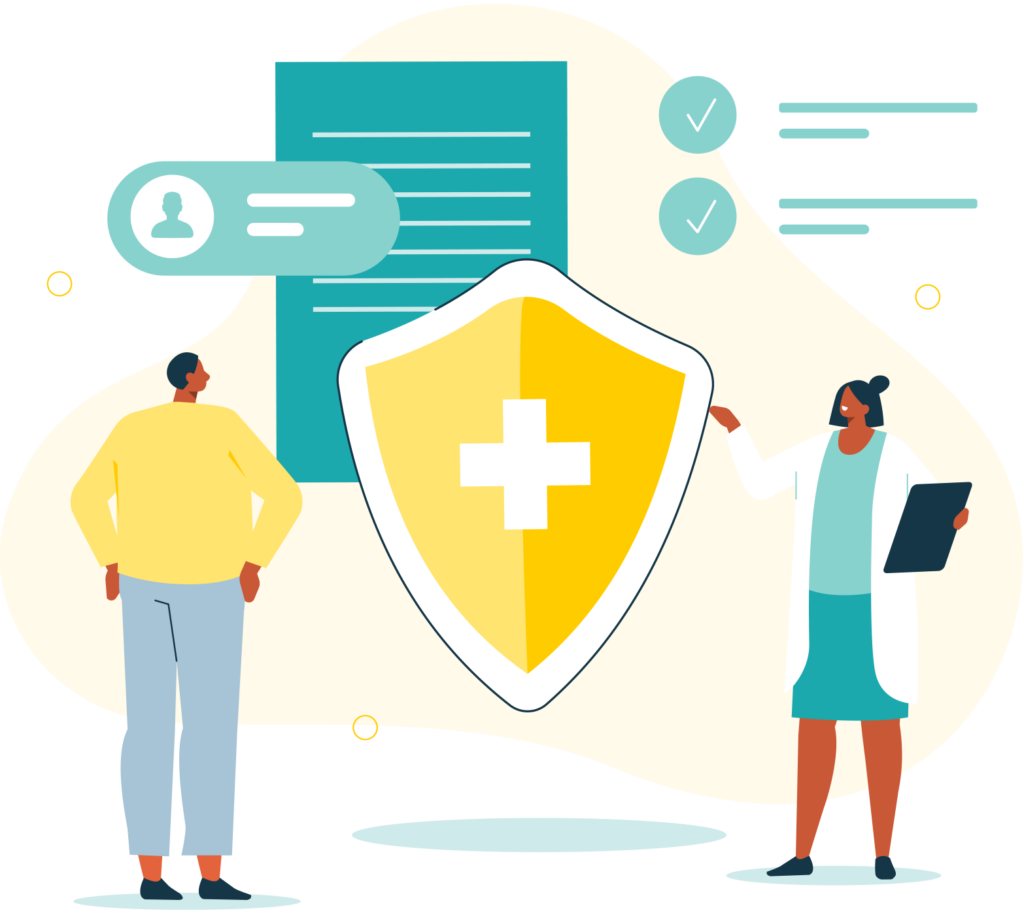When your child’s substance use takes you back to a place you hoped you’d never see again, it can feel like the ground has been pulled out from under you. You may be trying to make sense of what went wrong, or wondering what kind of help could truly make a difference this time.
A residential treatment program offers more than a safe place to detox. Detox focuses on the physical side—getting harmful substances out of the body in a medically supervised setting. Residential care goes further, prioritizing clinical programming that helps address the emotional, mental, and behavioral patterns that fuel substance use. For many young adults, this is the difference between short-term stability and long-term change.
Why Detox Alone Isn’t Enough
Detox is an essential first step for anyone physically dependent on drugs or alcohol. It provides medical monitoring to manage withdrawal symptoms, reduce complications, and increase comfort during those early, physically demanding days.
However, detox is limited in scope:
- It doesn’t address why your child uses—the underlying mental health issues, unresolved trauma, or learned coping mechanisms.
- It doesn’t build new skills for managing stress, relationships, or cravings.
- It doesn’t prepare them for triggers they’ll face once they return home or to daily life.
Many families feel hopeful when their child completes detox, only to be devastated weeks later when the same patterns resurface. Without deeper clinical intervention, detox can feel like hitting pause instead of changing the channel.
The Clinical Heart of Residential Treatment
Residential Treatment in Ohio is where recovery starts to grow roots. Once your child is medically stable, the focus turns to the emotional and psychological work of healing.
In a residential program, clinical care is comprehensive and individualized. It often includes:
- Individual therapy – Regular one-on-one sessions to explore personal struggles, motivations, and goals.
- Group therapy – Sharing experiences with peers to reduce isolation and increase accountability.
- Family counseling – Helping you and your child rebuild trust, improve communication, and set boundaries.
- Specialized therapeutic approaches – Such as cognitive behavioral therapy (CBT) for changing thought patterns, dialectical behavior therapy (DBT) for emotional regulation, or trauma-informed care for processing past wounds.
The goal is not simply to stop substance use, but to help your child create a new foundation for living—one that feels sustainable beyond treatment.
Structure That Supports Healing
For many young adults in active addiction, life has little structure. Sleep schedules are erratic. Meals are skipped. Days are spent chasing the next drink or high.
A residential treatment program offers a predictable, supportive routine that can be profoundly stabilizing. A day may look something like this:
- Morning: Wake-up, breakfast, and mindfulness exercises to set a calm, focused tone.
- Mid-morning: Individual therapy or educational workshops on topics like relapse prevention and healthy coping skills.
- Afternoon: Group therapy, recreational activities, or skill-building sessions such as art therapy or exercise.
- Evening: Dinner, reflection groups, and time for rest.
This daily rhythm helps your child experience what life can feel like without the chaos of substance use. It also allows them to practice consistency—something critical for recovery.
Addressing Co-Occurring Mental Health Needs
It’s common for substance use to be intertwined with mental health conditions such as depression, anxiety, PTSD, or bipolar disorder. Sometimes these issues existed before substance use began; other times, substance use triggered or worsened them.
Residential programs can address both simultaneously. Treating mental health alongside addiction is vital because leaving one untreated often undermines progress in the other. If your child leaves treatment without support for their depression or anxiety, for example, those symptoms can drive them back toward substances.
Integrated care—where clinical staff coordinate treatment for both conditions—offers a more complete and lasting path forward.
The Role of Family in Recovery
When your child is struggling, it’s natural to want to help. But in addiction recovery, “help” can sometimes unintentionally enable harmful patterns. Residential programs often include family involvement not just to update you on progress, but to equip you with tools and boundaries that truly support recovery.
This might include:
- Learning how to communicate without escalating conflict.
- Understanding addiction as a health condition, not a moral failing.
- Identifying and changing enabling behaviors.
- Creating a realistic plan for what support will look like after treatment.
By participating in family sessions or educational workshops, you become part of the healing process—without carrying the full weight of it yourself.
Why This Step Builds Hope
It’s easy to feel discouraged if your child has been to treatment before or relapsed after a period of sobriety. But each attempt at recovery is valuable. It brings new insights, builds new skills, and can help them get closer to stability.
A residential treatment program is not just about stopping the use of substances—it’s about changing the conditions that make using feel necessary. It’s about giving your child the space, tools, and professional guidance to believe in a life beyond addiction.
One parent once described it as, “Detox gave my son a break from the chaos. Residential treatment gave him the tools to build a different life.”
Frequently Asked Questions About Residential Treatment
How is residential treatment different from detox?
Detox is a short-term, medically focused process to safely manage withdrawal. Residential treatment builds on that stability with intensive clinical care to address the root causes of substance use.
Does my child need to detox before residential treatment?
If your child is physically dependent on substances, detox is typically the first step. Many residential programs work closely with detox facilities to ensure a smooth transition.
How long does residential treatment last?
Programs can range from 30 to 90 days or longer, depending on individual needs. The focus is on progress and readiness, not a fixed calendar date.
Will my child be able to continue school or work during treatment?
In most cases, residential treatment is a full-time commitment, which means school or work is paused. This allows your child to focus entirely on recovery. Transitional support can help them return to those responsibilities later.
Can our family visit during treatment?
Most programs allow family visits, often after an initial adjustment period. These visits may be structured to include therapy sessions, education, or planned activities.
How do I know if a residential program is right for my child?
If your child has struggled to stay sober after detox or outpatient care, or if they need intensive support for both substance use and mental health, residential treatment can provide the depth and consistency that other levels of care cannot.
Call (866)430-9267 or to learn more about our services visit our page residential treatment program in Hilliard, Ohio. Our team can guide you through each step so your child receives care that goes beyond detox and into the heart of recovery.



